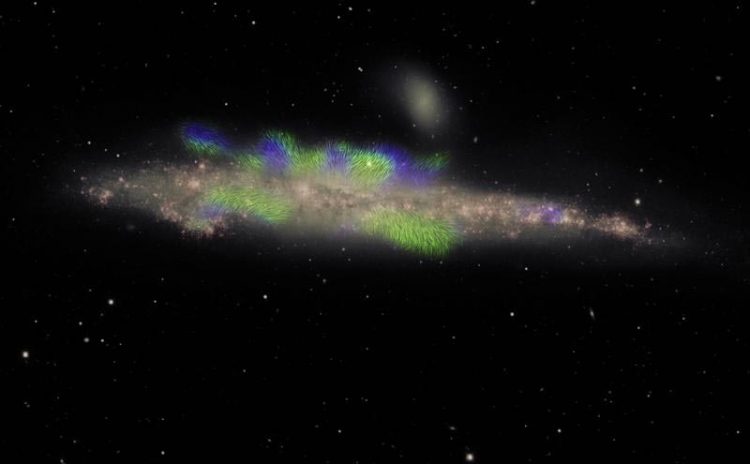Giant magnetic ropes in the outskirts of a spiral galaxy

The spiral galaxy NGC 4631 is seen edge-on, with its disk of stars shown in pink and the observed magnetic field pattern, extending beyond the disk into the galaxy's extended halo in green and blue. Composite: J. English. Radio data: Jansky-VLA (S. Mora-Partiarroyo et al. 2019). Opt. Data: Mayall 4m telescope (M. Patterson, R. Walterbos). Software program für magnetic field lines: A. Miskolczi.
NGC 4631, the “Whale Galaxy”, located 25 million light-years from Earth in the constellation Canes Venatici, is about 80 thousand light-years across, slightly smaller than our own Milky Way. It was discovered by the famous German-born British astronomer Sir William Herschel in 1787. This galaxy has a companion, NGC 4627, a small elliptical galaxy.
Observations of the polarized radio emission of NGC 4631, performed with the Karl G. Jansky Very Large Array (VLA), reveal regular magnetic fields protruding above and below the galaxy's disk (see Fig. 1).
“This is the first time that we have clearly detected what astronomers call large-scale, coherent, magnetic fields far in the halo of a spiral galaxy, with the field lines aligned in the same direction over distances of a thousand light-years. We even see a regular pattern of this organized field changing direction,” said Marita Krause, scientist at the Max Planck Institute for Radioastronomy (MPIfR) in Bonn, Germany, and corresponding author of the publication.
The strength of 4 microGauss for the regular magnetic field is surprisingly high for a halo, comparable with the regular magnetic field strength in the disks of spiral galaxies.
An international team of astronomers who are part of a project called the Continuum HAlos in Nearby Galaxies — an EVLA Survey (CHANG-ES), said the image indicates a large-scale, coherent magnetic field that is generated by dynamo action within the galaxy and spirals far outward in the form of giant magnetic ropes perpendicular to the disk. The CHANG-ES project is led by Judith Irwin of Queen's University in Ontario, Canada, a co-author of the paper.
“At the moment, I'm afraid that we are a little bit like the blind men and the
elephant, since each time we sample the magnetic field in a different way we reach a different conclusion about its nature! However, our models suggest this field includes smaller, twisting cones emanating from the spiral arms,” said Richard Henriksen, also of Queen's University.
The results were achieved by combining data from multiple observations with the VLA's giant dish antennas arranged in different configurations to show both large structures and finer details within NGC 4631. The naturally-emitted radio waves from that galaxy were analyzed to reveal the magnetic fields, including their directions.
The scientists said the techniques used to determine the direction of the magnetic field lines can now be used on other galaxies to answer important questions about whether coherent magnetic fields are common in galactic halos and what their shapes are.
The regular halo fields may also be regarded as a link to intergalactic magnetic fields and will help to understand their origin which is a mystery up to now.
——————————————
CHANG-ES, the “Continuum Halos in Nearby Galaxies, an EVLA Survey” project, brings together scientists from all over the globe in order to investigate the occurrence and origin of galaxy halos by means of radio observations.
The extended spherical area around the disk of a spiral galaxy is called halo. It forms the interface between the well-studied disks of galaxies and the intergalactic medium.
The National Radio Astronomy Observatory (NRAO) is a facility of the National Science Foundation (NSF), operated under cooperative agreement by Associated Universities, Inc. The Karl G. Jansky Very Large Array (VLA) interferometer near Socorro (New Mexico, USA) is operated by NRAO.
Authors of the original paper comprise Silvia Carolina Mora-Partiarroyo, Marita Krause, Aritra Basu, Rainer Beck, Theresa Wiegert, Judith Irwin, Richard Henriksen, Yelena Stein, Carlos J. Vargas, Volker Heesen, René A. M. Walterbos, Richard J. Rand, George Heald, Jiangtao Li, Patrick Kamieneski, and Jayanne English. The first four authors are all affiliated with the MPIfR in Bonn, Germany.
The results are based on the doctoral thesis of Silvia Carolina Mora-Partiarroyo, the first author, at MPIfR and Bonn University. The thesis was supervised by Marita Krause.
A theoretical model is described in Woodfinden et al. 2019 MNRAS, 487, 1498.
Dr. Marita Krause,
Max-Planck-Institut für Radioastronomie, Bonn.
Fon: +49-228-525-312
E-mail: mkrause@mpifr-bonn.mpg.de
S. C. Mora-Partiarroyo et al.: CHANG-ES XV: Large-scale magnetic field reversals in the radio halo of NGC 4631, Astronomy & Astrophysics 2019, A&A, 632, A11 (26 November 2019):
Media Contact
All latest news from the category: Physics and Astronomy
This area deals with the fundamental laws and building blocks of nature and how they interact, the properties and the behavior of matter, and research into space and time and their structures.
innovations-report provides in-depth reports and articles on subjects such as astrophysics, laser technologies, nuclear, quantum, particle and solid-state physics, nanotechnologies, planetary research and findings (Mars, Venus) and developments related to the Hubble Telescope.
Newest articles

Security vulnerability in browser interface
… allows computer access via graphics card. Researchers at Graz University of Technology were successful with three different side-channel attacks on graphics cards via the WebGPU browser interface. The attacks…

A closer look at mechanochemistry
Ferdi Schüth and his team at the Max Planck Institut für Kohlenforschung in Mülheim/Germany have been studying the phenomena of mechanochemistry for several years. But what actually happens at the…

Severe Vulnerabilities Discovered in Software to Protect Internet Routing
A research team from the National Research Center for Applied Cybersecurity ATHENE led by Prof. Dr. Haya Schulmann has uncovered 18 vulnerabilities in crucial software components of Resource Public Key…





















